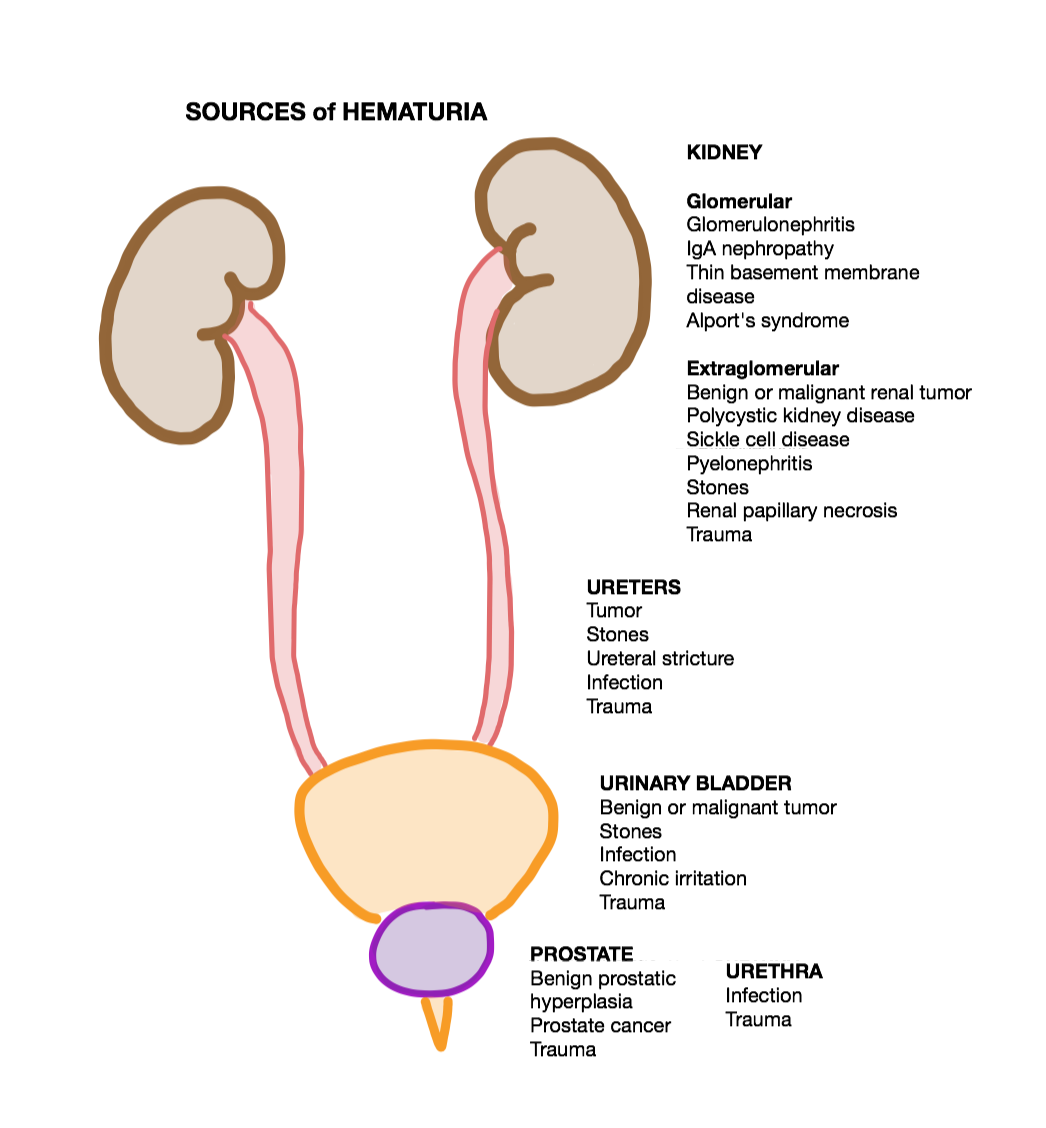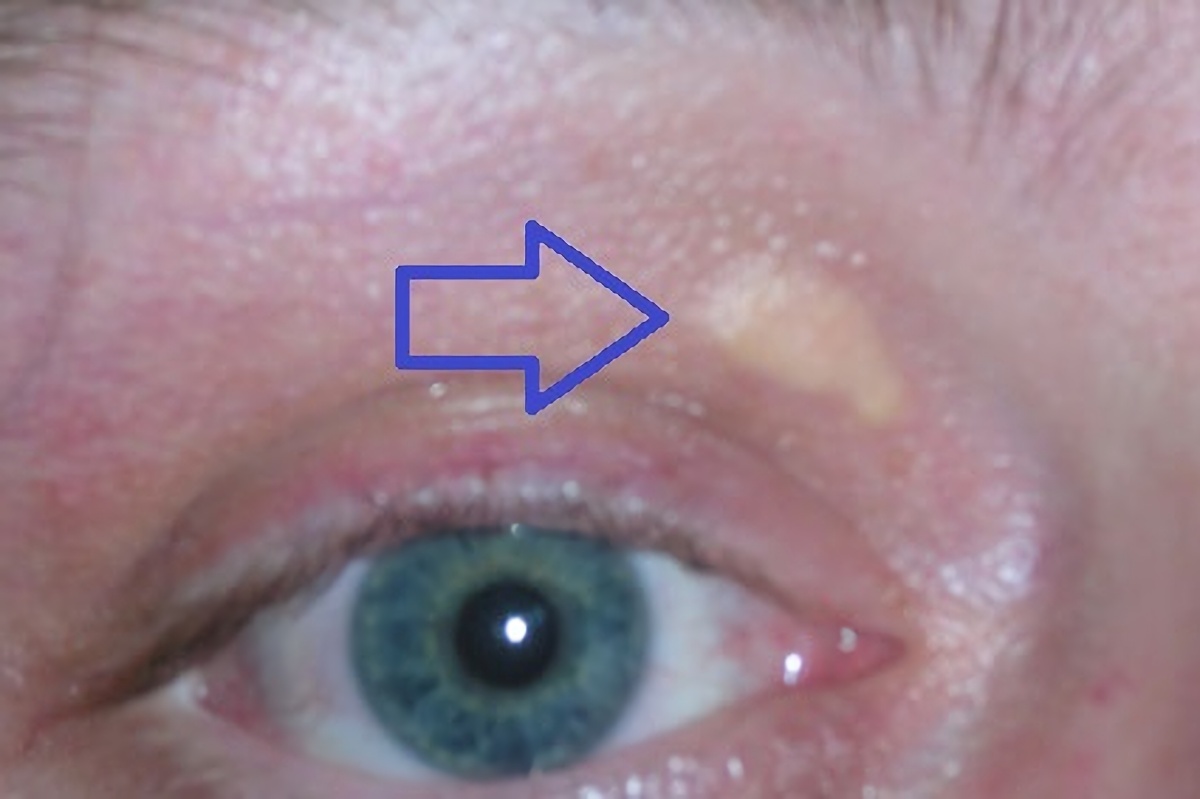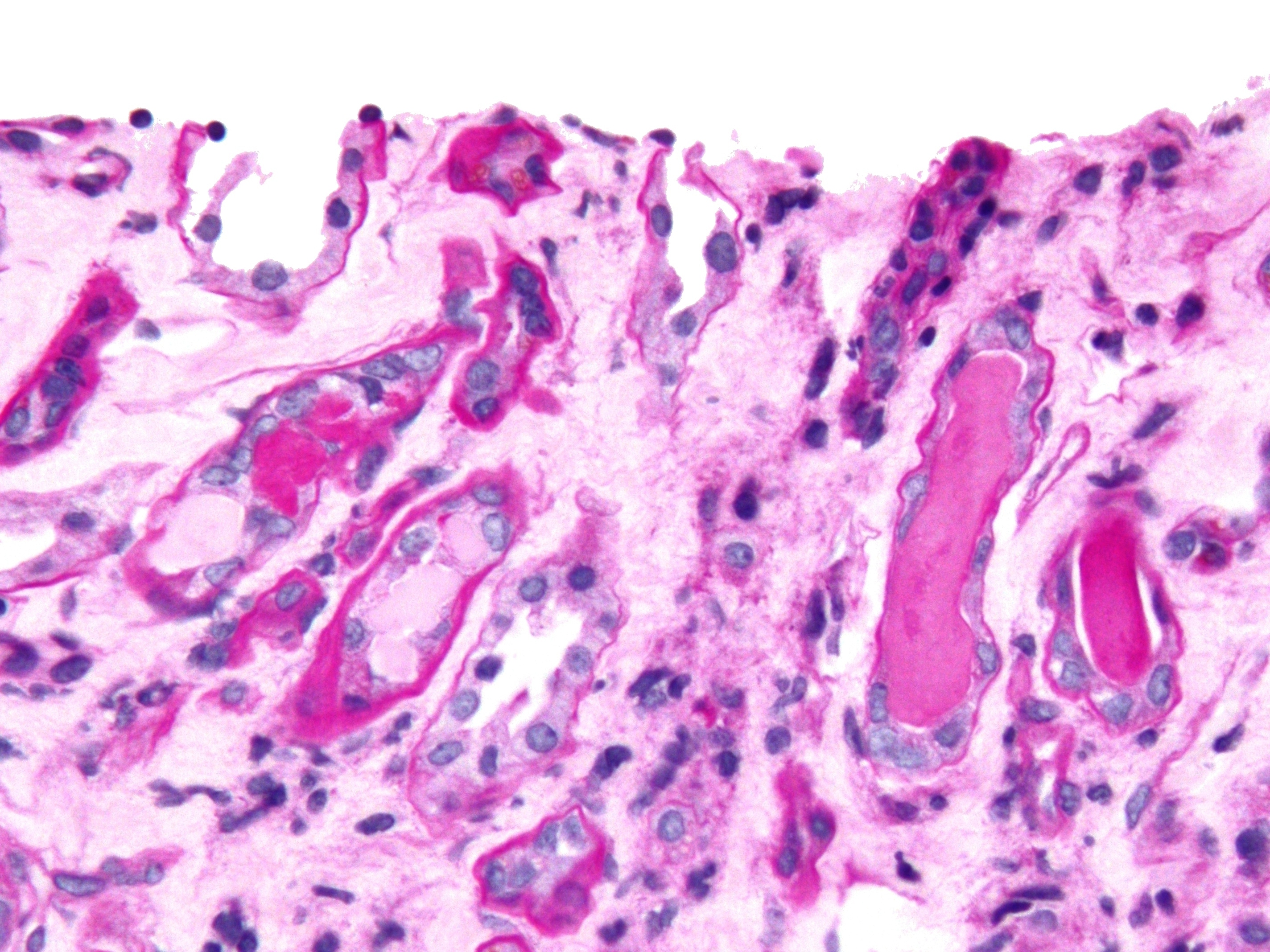|
Nephritic Syndrome
Nephritic syndrome is a syndrome comprising medical sign, signs of nephritis, which is kidney disease involving inflammation. It often occurs in the Glomerulus (kidney), glomerulus, where it is called glomerulonephritis. Glomerulonephritis is characterized by inflammation and thinning of the glomerular basement membrane and the occurrence of small pores in the podocytes of the Glomerulus (kidney), glomerulus. These pores become large enough to permit both proteins and red blood cells to pass into the urine (yielding proteinuria and hematuria, respectively). By contrast, nephrotic syndrome is characterized by proteinuria and a constellation of other symptoms that specifically do not include hematuria. Nephritic syndrome, like nephrotic syndrome, may involve hypoalbuminemia, low level of albumin in the blood due to the protein albumin moving from the blood to the urine. Signs and symptoms Historically, nephritic syndrome has been characterized by blood in the urine (hematuria), ... [...More Info...] [...Related Items...] OR: [Wikipedia] [Google] [Baidu] |
Oliguria
Oliguria or hypouresis is the low output of urine specifically more than 80 ml/day but less than 400ml/day. The decreased output of urine may be a sign of dehydration, kidney failure, hypovolemic shock, hyperosmolar Hyperglycemic Nonketotic Syndrome, hyperosmolar hyperglycemic nonketotic syndrome (HHNS), multiple organ dysfunction syndrome, urinary obstruction/urinary retention, diabetic ketoacidosis, diabetic ketoacidosis (DKA), pre-eclampsia, and urinary tract infections, among other conditions. Beyond oliguria is anuria, which represents an absence of urine, clinically classified as below 80 or 100 ml/day. The term oliguria is derived from ''oligo''-meaning "small, little," + -''uria'', from the Greek word ''ouron,'' meaning ''"''urine". Definition Oliguria is defined as a urine output that is less than 1 mL/kg/h in infants,Free Full Text< ... [...More Info...] [...Related Items...] OR: [Wikipedia] [Google] [Baidu] |
Albumin
Albumin is a family of globular proteins, the most common of which are the serum albumins. All of the proteins of the albumin family are water- soluble, moderately soluble in concentrated salt solutions, and experience heat denaturation. Albumins are commonly found in blood plasma and differ from other blood proteins in that they are not glycosylated. Substances containing albumins are called ''albuminoids''. A number of blood transport proteins are evolutionarily related in the albumin family, including serum albumin, alpha-fetoprotein, vitamin D-binding protein and afamin. This family is only found in vertebrates. ''Albumins'' in a less strict sense can mean other proteins that coagulate under certain conditions. See ' for lactalbumin, ovalbumin and plant "2S albumin". Function Albumins in general are transport proteins that bind to various ligands and carry them around. Human types include: * Human serum albumin is the main protein of human blood plasma. It m ... [...More Info...] [...Related Items...] OR: [Wikipedia] [Google] [Baidu] |
Nephrotic Syndrome
Nephrotic syndrome is a collection of symptoms due to kidney damage. This includes proteinuria, protein in the urine, hypoalbuminemia, low blood albumin levels, hyperlipidemia, high blood lipids, and significant edema, swelling. Other symptoms may include weight gain, feeling tired, and foamy urine. Complications may include blood clots, infections, and high blood pressure. Causes include a number of kidney diseases such as focal segmental glomerulosclerosis, membranous nephropathy, and minimal change disease. It may also occur as a complication of diabetes, lupus, or amyloidosis. The underlying mechanism typically involves damage to the Glomerulus (kidney), glomeruli of the kidney. Diagnosis is typically based on urinalysis, urine testing and sometimes a kidney biopsy. It differs from nephritic syndrome in that there are no red blood cells in the urine. Treatment is directed at the underlying cause. Other efforts include managing high blood pressure, high blood cholesterol, ... [...More Info...] [...Related Items...] OR: [Wikipedia] [Google] [Baidu] |
Proteinuria
Proteinuria is the presence of excess proteins in the urine. In healthy persons, urine contains very little protein, less than 150 mg/day; an excess is suggestive of illness. Excess protein in the urine often causes the urine to become foamy (although this symptom may also be caused by other conditions). Severe proteinuria can cause nephrotic syndrome in which there is worsening swelling of the body. Signs and symptoms Proteinuria often causes no symptoms and it may only be discovered incidentally. Foamy urine is considered a cardinal sign of proteinuria, but only a third of people with foamy urine have proteinuria as the underlying cause. It may also be caused by bilirubin in the urine ( bilirubinuria), retrograde ejaculation, pneumaturia (air bubbles in the urine) due to a fistula, or drugs such as pyridium. Causes There are three main mechanisms to cause proteinuria: * Due to disease in the glomerulus * Because of increased quantity of proteins in serum (overflo ... [...More Info...] [...Related Items...] OR: [Wikipedia] [Google] [Baidu] |
Hematuria
Hematuria or haematuria is defined as the presence of blood or red blood cells in the urine. "Gross hematuria" occurs when urine appears red, brown, or tea-colored due to the presence of blood. Hematuria may also be subtle and only detectable with a microscope or laboratory test. Blood that enters and mixes with the urine can come from any location within the urinary system, including the kidney, ureter, urinary bladder, urethra, and in men, the prostate. Common causes of hematuria include urinary tract infection (UTI), kidney stones, viral illness, trauma, bladder cancer, and exercise. These causes are grouped into glomerular and non-glomerular causes, depending on the involvement of the glomerulus of the kidney. But not all red urine is hematuria. Other substances such as certain medications and some foods (e.g. blackberries, beets, food dyes) can cause urine to appear red. Menstruation in women may also cause the appearance of hematuria and may result in a positive urine dips ... [...More Info...] [...Related Items...] OR: [Wikipedia] [Google] [Baidu] |
Hyperlipidemia
Hyperlipidemia is abnormally high levels of any or all lipids (e.g. fats, triglycerides, cholesterol, phospholipids) or lipoproteins in the blood. citing: and The term ''hyperlipidemia'' refers to the laboratory finding itself and is also used as an umbrella term covering any of various acquired or genetic disorders that result in that finding. Hyperlipidemia represents a subset of dyslipidemia and a superset of hypercholesterolemia. Hyperlipidemia is usually chronic and requires ongoing medication to control blood lipid levels. Lipids (water-insoluble molecules) are transported in a Apolipoprotein, protein Lipoprotein, capsule. The size of that capsule, or lipoprotein, determines its density. The lipoprotein density and type of apolipoproteins it contains determines the fate of the particle and its influence on metabolism. Hyperlipidemias are divided into primary and secondary subtypes. Primary hyperlipidemia is usually due to genetic causes (such as a mutation in a recepto ... [...More Info...] [...Related Items...] OR: [Wikipedia] [Google] [Baidu] |
Edema
Edema (American English), also spelled oedema (British English), and also known as fluid retention, swelling, dropsy and hydropsy, is the build-up of fluid in the body's tissue (biology), tissue. Most commonly, the legs or arms are affected. Symptoms may include skin that feels tight, the area feeling heavy, and joint stiffness. Other symptoms depend on the underlying cause. Causes may include Chronic venous insufficiency, venous insufficiency, heart failure, kidney problems, hypoalbuminemia, low protein levels, liver problems, deep vein thrombosis, infections, kwashiorkor, angioedema, certain medications, and lymphedema. It may also occur in immobile patients (stroke, spinal cord injury, aging), or with temporary immobility such as prolonged sitting or standing, and during menstruation or pregnancy. The condition is more concerning if it starts suddenly, or pain or shortness of breath is present. Treatment depends on the underlying cause. If the underlying mechanism involve ... [...More Info...] [...Related Items...] OR: [Wikipedia] [Google] [Baidu] |
Uremia
Uremia is the condition of having high levels of urea in the blood. Urea is one of the primary components of urine. It can be defined as an excess in the blood of amino acid and protein metabolism end products, such as urea and creatinine, which would normally be excreted in the urine. ''Uremic syndrome'' can be defined as the terminal clinical manifestation of kidney failure (also called ''renal failure''). It is the signs, symptoms and results from laboratory tests which result from inadequate excretory, regulatory, and endocrine function of the kidneys. Both ''uremia'' and ''uremic syndrome'' have been used interchangeably to denote a very high plasma urea concentration that is the result of renal failure. The former denotation will be used for the rest of the article. Azotemia is a similar, less severe condition with high levels of urea, where the abnormality can be measured chemically but is not yet so severe as to produce symptoms. Uremia describes the pathological and symp ... [...More Info...] [...Related Items...] OR: [Wikipedia] [Google] [Baidu] |
Azotemia
Azotemia (), also spelled azotaemia, is a medical condition characterized by abnormally high levels of nitrogen-containing compounds (such as urea, creatinine, various body waste compounds, and other nitrogen-rich compounds) in the blood. It is largely related to insufficient or dysfunctional filtering of blood by the kidneys. It can lead to uremia and acute kidney injury (kidney failure) if not controlled. Types Azotemia has three classifications, depending on its causative origin: prerenal azotemia, renal azotemia, and postrenal azotemia. Measurements of urea and creatinine (Cr) in the blood are used to assess renal function. For historical reasons, the lab test measuring urea is known as " blood urea nitrogen" (BUN) in the US. The BUN:Cr ratio is a useful measure in determining the type of azotemia and will be discussed in each section below. A normal BUN:Cr is equal to 15. Prerenal azotemia Prerenal azotemia is caused by a decrease in blood flow ( hypoperfusion) to the ki ... [...More Info...] [...Related Items...] OR: [Wikipedia] [Google] [Baidu] |
Pyuria
Pyuria is the condition of urine containing white blood cells or pus. Defined as the presence of 6-10 or more neutrophils per high power field of unspun, voided mid-stream urine, it can be a sign of a bacterial urinary tract infection. Pyuria may be present in people with sepsis, or in older people with pneumonia. Others additionally require discoloration, clouding or change in the smell of urine for a pyuria to be present. Without these additional features, there is said to be leukocyturia. Sterile pyuria is urine which contains white blood cells while appearing sterile by standard culturing techniques. It is often caused by sexually transmitted infections, such as gonorrhea, or viruses which will not grow in bacterial cultures. Sterile pyuria is listed as a side effect from some medications such as paracetamol (acetaminophen). Its occurrence is also associated with certain disease processes, such as Kawasaki disease and genitourinary tuberculosis. However, there are many k ... [...More Info...] [...Related Items...] OR: [Wikipedia] [Google] [Baidu] |
Urinary Cast
Urinary casts are microscopic cylindrical structures produced by the kidney and present in the urine in certain disease states. They form in the distal convoluted tubule and collecting ducts of nephrons, then dislodge and pass into the urine, where they can be detected by microscopy. They form via precipitation of Tamm–Horsfall protein, Tamm–Horsfall mucoprotein, which is secreted by renal tubule cells, and sometimes also by albumin in conditions of proteinuria. Cast formation is pronounced in environments favoring protein denaturation and precipitation (low flow, concentrated salts, low pH). Tamm–Horsfall protein is particularly susceptible to precipitation in these conditions. Casts were first described by Henry Bence Jones (1813–1873). As reflected in their cylindrical form, casts are generated in the small distal convoluted tubules and collecting ducts of the kidney, and generally maintain their shape and composition as they pass through the urinary system. Although ... [...More Info...] [...Related Items...] OR: [Wikipedia] [Google] [Baidu] |
Oliguria
Oliguria or hypouresis is the low output of urine specifically more than 80 ml/day but less than 400ml/day. The decreased output of urine may be a sign of dehydration, kidney failure, hypovolemic shock, hyperosmolar Hyperglycemic Nonketotic Syndrome, hyperosmolar hyperglycemic nonketotic syndrome (HHNS), multiple organ dysfunction syndrome, urinary obstruction/urinary retention, diabetic ketoacidosis, diabetic ketoacidosis (DKA), pre-eclampsia, and urinary tract infections, among other conditions. Beyond oliguria is anuria, which represents an absence of urine, clinically classified as below 80 or 100 ml/day. The term oliguria is derived from ''oligo''-meaning "small, little," + -''uria'', from the Greek word ''ouron,'' meaning ''"''urine". Definition Oliguria is defined as a urine output that is less than 1 mL/kg/h in infants,Free Full Text< ... [...More Info...] [...Related Items...] OR: [Wikipedia] [Google] [Baidu] |



